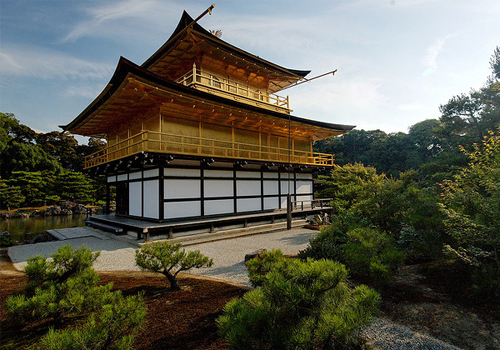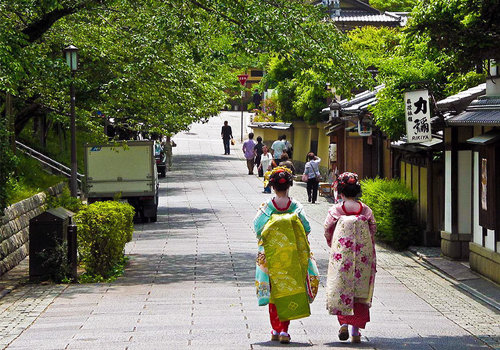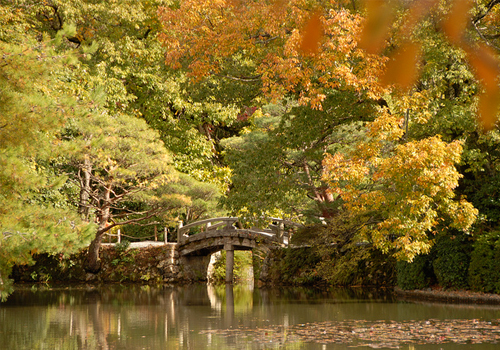Kyoto Travel Guide
Kyoto Imperial Palace
Address: 3 Kyotogyoen, Kamigyo Ward, Kyoto Kyoto
Japan's imperial family lived in the Kyoto palace from 1331 until 1868 (when they moved to Tokyo), and today visitors can view the furnishings and delicate decorations. Once only accessible via a guided tour that required advanced booking, the palace grounds can now be entered and viewed at the visitor's leisure without any prior arrangements. English guided tours are, however, still possible, and those interested should book a space in advance in order to avoid disappointment by calling at the Imperial Household Agency office. Visitors should note that even on the official tours it is impossible to enter any of the palace buildings, although you should be shown a video and photos showcasing the interiors. There are lockers at the site to store anything you don't want to carry while walking around the complex.<br /><br />
To-ji
Address: 1 Kujo-cho, Minami-ku Kyoto
To-ji, with the tallest pagoda in Japan, was the Buddhist temple founded in 794 as guardian of the then young capital city's welfare. Today it stands about 10 minutes' walk to the south of Kyoto Station, drawing curious tourists to admire in particular its five-storey pagoda, which was rebuilt in the mid-17th century. During the span of centuries a treasure trove of statuary, calligraphy and paintings has been collected at the temple, now housed in the various historic buildings making up the temple complex. The statues include a six-metre-tall Senju Kannon (thousand-armed Buddhist Goddess of Mercy) carved in 877. The gardens at the temple are lovely and the temple is an active place of worship which holds many ceremonies and religious services, giving the place a serene and authentic atmosphere which the popular tourist temples sometimes lack. Although many foreigners do choose to visit To-ji, the majority of people at the temple are locals there to pray and worship. There are many temples in the area but To-ji stands out because of its historic pagoda.<br /><br />
Golden Pavilion (Kinkakuji)
Address: 1 Kinkaku-ji-cho Kita-ku, Kyoto Kyoto
One of Kyoto's most popular attractions is to the north of the city. The Golden Pavilion (Kinkakuji) is a three-storey pavilion covered in gold leaf, glittering in the waters of a calm pond and surrounded by beautiful gardens. Kinkakuji was built in 1397 as a retirement home for Shogun Ashikaga Yoshimitsu, who lived there in luxury until he died in 1408, after which the building was converted into a Zen temple. In 1950 a mad monk burnt the pavilion down, and it was not rebuilt until 1955. Today it is covered in gold leaf five times thicker than the original coating, and presents an awesome sight. The pavilion is worth visiting at any time of the day and in any season - in fact, it is strikingly magnificent in winter, when surrounded by white snow. Although sunset can be particularly special, because the temple glows in the setting sun, the popularity of the place means that there are often big crowds and the best time to visit to really experience the tranquillity and beauty of the pavilion is early in the morning. A short walk from the pavilion is Ryoanji, Japan's most famous Zen rock garden, laid out in the 15th century. A veranda overlooks the garden in which 15 rocks are set among raked white pebbles.<br /><br />
Sanjusangen-do
Address: Shichijo Dori Kyoto
The temple of Rengeoin, in eastern Kyoto, is better known by its popular name of Sanjusangen-do, and houses an amazing sight. Inside the longest wooden building in Japan stand row upon row of life-sized statues of Kannon, the goddess of mercy, carved from Japanese cypress and covered in gold leaf, dating back to the 12th and 13th centuries. There are 1,000 statues altogether and each is unique, bearing a religious symbol or making a religious gesture. The statues surround the large, central figure of a seated Kannon, carved in 1254 in the Kamakura Period. The building and statues were once part of a large Buddhist temple complex known as the Lotus King Temple which was sadly destroyed leaving only a few buildings intact. The effect of all the golden statues, which create a kind of yellow haze, is mystical and somewhat hypnotic, giving credence to the local myth that if you stare at them for long enough one of the statues will assume the form of a loved one. No photos are allowed inside but you are permitted to photograph the outside of the building and the lovely grounds. There is a gift shop where you can buy some souvenirs at a reasonable cost. There are guides and prayer books in English for those who want more information.<br /><br />
Gion
Address: Gion, Higashiyama-ku, Kyoto City Kyoto
Most visitors to Japan are fascinated with the traditional Geisha: white-faced kimono-clad women specially trained to entertain and spoil men in a soothing setting. Kyoto boasts one of the most famous Geisha districts in the country, a neighbourhood of plain wooden buildings to the east of the Kamo River known as Gion. There were once thousands of Geisha and Maiko (apprentice Geisha) performing their genteel tasks in this area. Today the number has dwindled to a few hundred, but visitors who stroll the Hanami-koji street at sunset, past teahouses and restaurants, will probably catch a glimpse of one or two en route to the Geisha houses in their clattering wooden shoes and full traditional finery. The Geisha houses themselves are sadly strictly off-limits to anyone not properly introduced and invited, but from behind the paper screens you will hear the strains of music and laughter. It is fascinating to read up on the Geisha tradition before visiting the area but it also seems fitting that the Geisha still retain their mystery behind the paper screens. While geisha-spotting in the Gion district, take in the Yasaka Shrine with its many paper lanterns and the Minamiza Kabuki Theatre.<br /><br />
Kiyomizu-dera
Address: Kyoto
The 'Pure Water Temple', Kiyomizu-dera, is one of Japan's most celebrated temples, founded in 780 and associated with Nara Buddhism, the oldest sect in Japan. The temple is a UNESCO World Heritage Site and one of its main features for tourists is the lovely view afforded of the wooded hills of eastern Kyoto from its terrace. Below the terrace is the spring from which the temple got its name; visitors can sample the water, which is said to have healing powers. Nearby is an interesting three-storey pagoda, and the Otawa Falls. The approach to the temple, along Kiyomizu-michi or Gojo-zaka, is steep and narrow, the streets lined with stores specialising in local sweets, pottery and the inevitable souvenirs. Behind the temple is the Shinto Jishu Shrine, dedicated to the god of love. There is lots to see and do in the temple complex, which tends to be bustling with visitors and worshipers, and provides a fascinating cultural and historical experience for foreigners. The gardens are beautiful and, like many in Japan, are at their best when the cherry blossoms bloom in spring or when the leaves are at their most radiant in autumn. It is especially lovely to stay until it is dark (when possible) to see the temple light up at night.<br /><br />
Katsura Imperial Villa
Address: Kyoto
Considered to be the finest example of pure Japanese architecture and garden design, Katsura Rikyu, built in 1645 by Prince Toshihito, is beautiful in its simplicity. The buildings are constructed of entirely natural materials and consist of a moon-viewing pavilion, an imperial hall, teahouse and the wooden villa itself. The garden is designed for leisurely strolls with surprises around each turn of the path, from stone bridges and lanterns to ponds and manicured trees. The grounds are particularly beautiful in the autumn, when the rich colours of the trees make for even better photos than usual. It is very interesting to see how the imperial families lived and the Katsura Imperial Villa is one of the most popular attractions in Kyoto.<br /><br /> The villa may be visited only on pre-arranged, guided tours organised by the Imperial Household Agency, with tours held each weekday, on Sundays and occasionally on Saturdays. Tours are in Japanese only, and can be arranged at the office of the Imperial Household Agency next to the Imperial Palace in central Kyoto. Foreigners will be given audio guides. The villa is closed between roughly 28 December and 4 January and for imperial functions. Be sure to take along your passport when you apply for a permit, and book at least a day in advance.<br /><br />
Nara
Address: Kyoto
The city of Nara, 26 miles (42km) south of Kyoto, could be regarded as the place where Japan's culture was formalised. The city, originally called Heijo, became the first permanent capital of the country in 710. Although its capital status only lasted for 74 years, they were years that entrenched and enshrined Japan's arts, crafts and literature. Nara flourished as a political and cultural centre and thus was blessed with numerous temples, shrines, pagodas and palaces, which today attract locals and foreigners intent on glimpsing historic Japan. Most of Nara's historic treasures are conveniently contained in a vast park which has been designated a UNESCO World Heritage Site, making sightseeing easy and pleasurable. Highlights are Todaiji, the huge temple that contains Japan's largest Buddha statue, and Horyuji, the temple containing the world's oldest wooden structures. A good way to explore the city is on a historic walking tour and visitors should ensure that they take a stroll around the old Naramachi merchant district. It is easy to find your way around and enjoy a solitary foray into history with a guidebook should you so desire, but joining a guided tour can be very informative.<br /><br />
Minamiza Kabuki Theatre
Address: 198 Nakanomachi Yamatooji Nshi-iru, Shijo Ohashi, Higashiyama-ku Kyoto
Kabuki is a traditional Japanese dance-drama known for its stylised take of performance and the elaborate make-up worn by some performers. It is a very old art form, which had its golden age in the late 17th and early 18th centuries. Today it is the most popular style of traditional Japanese drama and its star actors can be seen in television and film roles as well as on the stage.<br /><br /> While there are many wonderful places in Japan to view Kabuki theatre, the Kyoto Minamiza Theatre is one of the principal venues for such performances and a major hub for the art form. The building itself is an architectural wonder, built in a traditional style in 1929, on the edge of the Geisha district of Gion. Visitors can pay to see individual acts of plays or to see the entire performance. Because the theatre has become popular among tourists, an English voice-over or purchasable programme explains the show to foreigners. A trip to the theatre is a fascinating cultural experience and shouldn't be missed by any tourists with an interest in theatre and Japanese culture. For the uninitiated, one act is generally enough. It is often best to begin with an individual act and then book for a full performance if you enjoy it.<br /><br />
(Data provided outside US and Canada by Foreca, Data provided for US and Canada by WDT)
| Jan | Feb | Mar | Apr | May | Jun | Jul | Aug | Sep | Oct | Nov | Dec | |
| Average High | 8° | 9° | 12° | 19° | 23° | 27° | 31° | 32° | 28° | 22° | 16° | 11° |
| Average Low | -1° | -- | 1° | 7° | 11° | 16° | 21° | 22° | 18° | 11° | 5° | -- |
(Data provided outside US and Canada by Foreca, Data provided for US and Canada by WDT)
| Jan | Feb | Mar | Apr | May | Jun | Jul | Aug | Sep | Oct | Nov | Dec | |
| Average High | 46° | 48° | 53° | 66° | 73° | 80° | 87° | 89° | 82° | 71° | 60° | 51° |
| Average Low | 30° | 32° | 33° | 44° | 51° | 60° | 69° | 71° | 64° | 51° | 41° | 32° |


